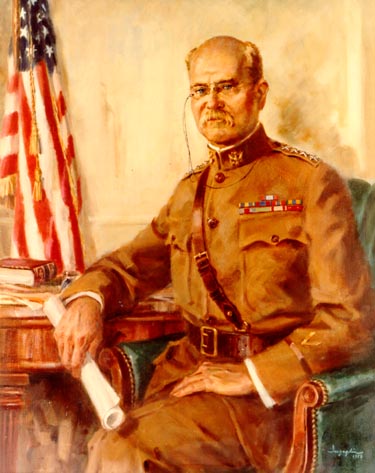
Tasker Howard Bliss was born in Lewisburg, Pennsylvania, on 31 December 1853; graduated from the United States Military Academy, 1875; was commissioned second lieutenant and assigned to the 1st Artillery, June 1875; performed routine garrison duties in Georgia and New York, 1875–1876; was assistant professor of French and assistant instructor of artillery tactics at West Point, 1876–1880; was promoted to first lieutenant, July 1880; was again on garrison duty in Connecticut and California, 1880–1882; married Eleanore E. Anderson, 1882; was adjutant of the Artillery School at Fort Monroe, 1884–1885, recorder of the Board on Interior Waterways, 1884, and instructor at the Naval War College, 1885–1888; was aide to the commanding general of the Army and concurrently inspector of artillery and small arms target practice, 1888–1895; was promoted to captain and staff subsistence (commissary) officer, 1892; was on special duty in the Office of the Secretary of War, 1895–1897; was military attache to Spain, 1897–1898; was promoted to major and staff commissary officer, 1898; was promoted to lieutenant colonel of volunteers and chief commissary officer, May 1898; was chief of staff of the 1st Division, I Corps, in the Puerto Rican campaign, 1898, collector of customs for the port of Havana and island of Cuba, 1898–1899, and president of the commission to revise the Cuban tariff, 1901; was promoted to brigadier general of volunteers, 1901; was a member of the War College Board, 1902; was promoted to brigadier general in the Regular Army, July 1902; served as chief of the Third Division, General Staff, and as president of the Army War College, August 1903–June 1905; was successively commander of the Departments of Luzon and Mindanao, governor of Moro Province, and commander of the Philippines Division, 1905–1909; returned to the General Staff and again headed the Army War College, 1909–1910; served successively as commander of the Departments of California, 1910–1911, the East, 1911–1913, and the South, 1913–1915; was assistant chief of staff of the United States Army, February 1915–September 1916; was promoted to major general, November 1915, and to temporary general, October 1917; was chief of staff of the United States Army, 22 September 1917–18 May 1918; visited Europe twice to observe conditions at the front and serve as the War Departments representative with the American section of the Supreme War Council at Versailles, his reports contributing to the formulation of policy and the prosecution of the war; was a delegate to the Paris Peace Conference, 1918–1919; was governor of the Soldiers’ Home in Washington, D.C., 1920–1927; retired from active service, June 1930; was advanced to general on the retired list by act of Congress, June 1930; died in Washington, D.C., on 9 November 1930.
The Artist
Frank Ingoglia (1907–) was born in Brooklyn, New York, and has been an active artist from an early age. At nine he won the Wanamaker Award in a city-wide contest for school children. He graduated from the Fawcett School of Applied Arts and then attended the Art Students League, where he studied under George Bridgman, Alvin Kleinfeld, and Kinon Nickolaides before entering upon a career in design and illustration. In 1950 he turned to portraiture, studying with Jerry Farnsworth, Robert Phillips, Wallace Bassford, and Sam Oppenheim. He maintains a studio at home in Forest Hills, New York, where he does some private tutoring. His work has been widely exhibited and his illustrations have appeared in national newspapers and magazines. He also painted General Malin Craig’s portrait.
Tasker Howard Bliss
By Frank Ingoglia
Oil on canvas, 40" x 32", 1973
[106]

page updated 30 April 2001